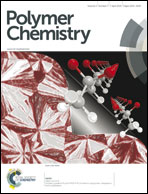Reduction-sensitive functionalized copolyurethanes for biomedical applications
Abstract
In the present paper we combine functionalization and biodegradation in the rational design of polymers that can be used as carrier systems for drug delivery in the colon. Functionalization of new polyurethanes (PUs) was achieved by thiol–ene coupling reactions, a simple and straightforward procedure included among the so-called click reactions, which are currently accepted as one of the most powerful tools in organic chemistry. Enhancement of the degradability of the new materials by the introduction of disulfide linkages into the polymer backbone has led to a new group of stimulus-responsive sugar-based polyurethanes able to be degraded by tripeptide glutathione under physiological conditions. Atomic Force Microscopy (AFM) on solid-supported multilayered dry polymer films—prepared by spin-coating from dimethylsulfoxide solutions—was used to study the morphology of the polymers and the degradation process in reductive environments. Matrix systems containing polymers selected according to their rheological properties were also investigated as modulated methotrexate-release systems.


 Please wait while we load your content...
Please wait while we load your content...